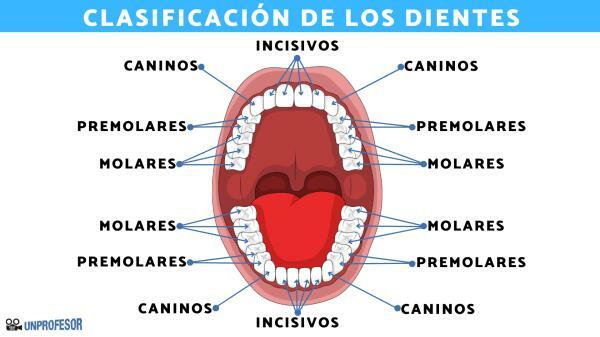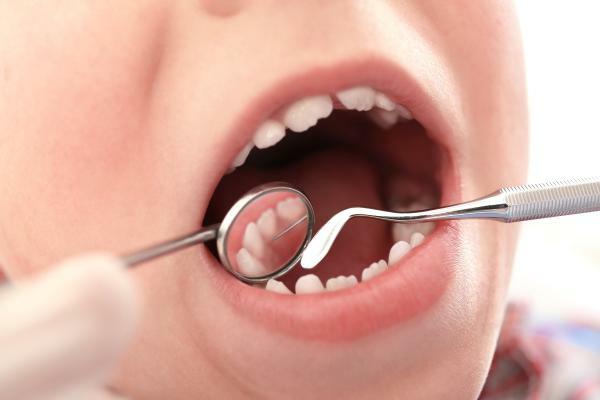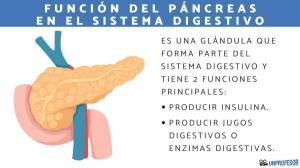Teeth classification

Humans have 32 teeth that are classified into 4 types of teeth different: 8 incisors, 2 canines or fangs, 8 premolars and 12 molars. We have our first baby teeth and our final ones. They are surprising structures that play a fundamental role in the adaptation and evolution of species over time. These pieces of anatomy, which at first glance seem simple, boast astonishing complexity in their structure and function.
In this lesson from a TEACHER, we are going to explain in detail what is the classification of teeth and the importance of each of them.
Index
- What are teeth?
- The 4 types of teeth
- milk teeth
- FDI dental nomenclature
What are teeth?
We humans have 32 dental pieces or teeth that are very hard structures implanted in the dental arches of the jaws. Together, they form the teeth.
If you are a fan of police series, you will know that teeth are as unique as fingerprints. Each tooth is made up of two distinct parts:
- Crown: It is the white part that we see in the mouth and that is superficial.
- Root: It is the inner part that is inserted into the jaw bone. It is what allows the tooth to remain fixed and anchored in the bone.
Each tooth has a single crown, but the number of roots will depend on the type of tooth we are studying.
The 4 types of teeth.
Teeth serve to chew and cut food, allowing us to have good digestion. There are 4 types of teeth and each of them has a different shape and fulfills a particular function.
Incisive teeth
The incisor teeth are 8 pieces dental that we have in the center front part of the mouth. We have 4 at the top and 4 at the bottom. These are the teeth you usually use to take bites of food and cut it from a larger piece.
The incisors are the first teeth to emerge, at 6 months of age, usually in the case of baby teeth and between 6 and 8 years in the case of permanent teeth.
Canine teeth
The canine teeth are 4 pieces and it is the next type of tooth that develops. Vulgarly, we know them as fangs and they are the pointed teeth that are next to the incisors. Its main function is tear food.
The milk canines appear between the 16 and 20 months old and usually the upper ones develop earlier than the lower ones. As for the permanent teeth, the order is reversed, around the age of 9 the permanent lower canines appear, while the upper canines do not arrive until 11 or 12 years of age.
Premolar teeth
The premolar teeth, are also known as bicuspids and serve for 1st chewing phase: to grind food. Have 8 premolars, 4 at the top and another 4 at the bottom of the mouth. The first premolars appear around the age of 10 and the second ones approximately a year later.
molar teeth
Last we have 12 molar teeth that are used for chew and grind food. Baby molars appear between 12 and 15 months of age. These molars are replaced by the definitive first and second premolars, placing 4 above and 4 below the jaw.
The permanent molars grow behind the baby molar teeth, expelling them. The first permanent molars begin to develop at 6 years, before the baby molars fall out. Second molars, on the other hand, appear between 11 and 13 years of age.
The third molars are known as the wisdom teeth. They are the last teeth to develop and do not appear until the 18 or 20 years old. Some people don't even develop them. If its development causes problems due to lack of space in the mouth, its extraction is advisable.

Milk teeth.
While we were explaining the types of permanent teeth that adults have in their teeth, we have talked several times about the baby teeth, but what exactly are they?
Children's teeth begin to emerge From 6 months old. The technical term to name baby teeth correctly is "deciduous dentition", because over time they end up falling. We can also find them under the name "primary teeth" or "baby teeth."
The children have, in total, 20 baby teeth, which are located 10 in the upper part of the mouth and 10 in the lower part. These teeth function as Placeholders, so that adult teeth know where they have to grow. Permanent teeth grow in exactly the same place where baby teeth fall out.
Starting at 6 years of age, baby teeth begin to fall out and are replaced with adult teeth. This process will continue until early adolescence.

FDI dental nomenclature.
This is the method used to name teeth, so that dentists and professionals in the sector quickly know which tooth they are referring to. The FDI nomenclature was officially developed by the International Dental Federation and identifies teeth through a graphic representation. There are other ways to name teeth, but this is the most common.
Its about split the two jaws, the upper and lower arches, in 4 quadrants, from the central line that is positioned between the central incisors and backwards.
He first quadrant It would be the one located in the upper right part of our mouth, the second quadrant in the upper left, the third quadrant corresponds to the lower left part and, finally, the fourth quadrant It is the one found in the lower right area. That is, we list the parts of the denture in the counterclockwise.
We hope that this lesson has helped you understand the classification of teeth and the function of each of them a little better. If you want to continue learning more about this topic or something similar, do not hesitate to consult our biology section.
As now you know better the classification of teeth, we recommend you continue learning with this other lesson from a TEACHER about What are the parts of teeth?
If you want to read more articles similar to Teeth classification, we recommend that you enter our category of biology.
Bibliography
- Cruz, E. TO. (2014). Classification of supernumerary teeth: literature review.
- Lucas-Rincón, S. E., Medina-Solís, C. E., Pontigo-Loyola, A. P., Robles-Bermeo, N. L., Lara-Carrillo, E., Veras Hernández, M. TO.,... & Casanova-Rosado, J. F. (2017). Natal and neonatal teeth: a review of the literature. Pediatrics (Asunción), 44(1), 62-70.



